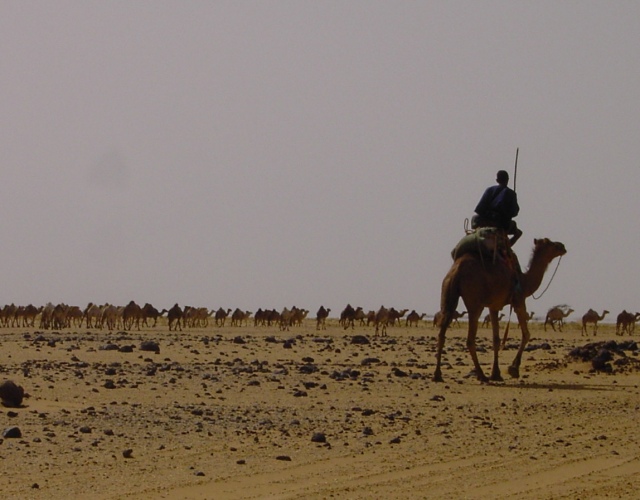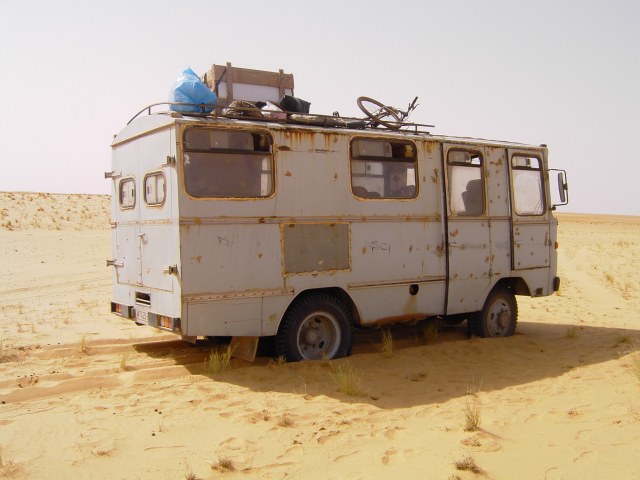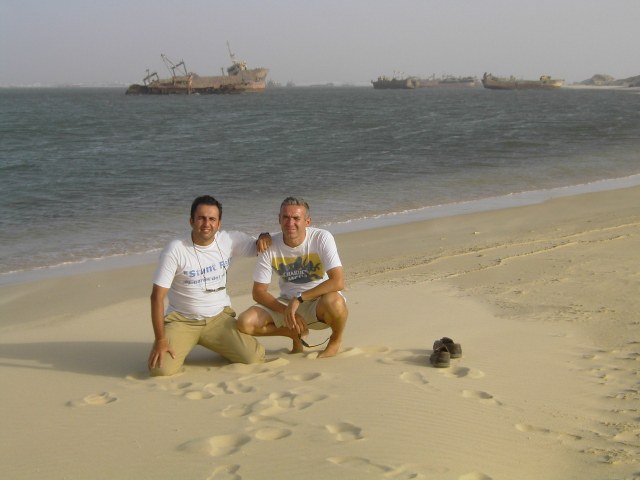18 Nov Western Sahara
Today I am melancholic and I want to show you a bit of Western Sahara, our former province 53, one of the places I like the most in the world. I like it so much that I have been there every time I could, by taxi, by car, by motorbike, by truck... I will never get tired of going there.
We will travel along the coast, from north to south.
The first village you come across is Tan Tan, ceded by Spain to Morocco in 56. This is where the Draa river appears, which I told you disappeared in Mhamid.

Tan Tan's Moussem, a festival of nomadic tribes that is part of UNESCO's intangible heritage, is famous. By the way Kitin, let's see what happens this year with our invitations, if you're reading me, speak up!

We continue south and enter the area of Cabo Juby. Here Villa Bens or Tarfaya, whatever you want to call it, stands out. It is famous because Antoine de Saint-Exupéry lived here in 1927 as a stopover manager for the French company Aéropostal, which covered the Toulouse-Saint-Louis de Senegal line in stages. On the beach there is a memorial to him.
I like the beach very much, I took this photo there on one of my trips back home.

There are about 10 stranded boats, the last one in 2008, the Armas, with 113 passengers on board, which were saved thanks to the help of the fishermen of Tarfaya.

We continue south. We reach the capital of the province, El Aaaiun, the de jure capital of SADR. It is located inland, 28 km from the coast, along the dry riverbed of the Saguia el Hamra. The photo is taken from the city

At one time it even had a Parador, which was inaugurated by Fraga, and still exists (the Parador too). The colonial part of the city has this colour:

On the coast is the Aaiun Beach, which, if you think about it, is a beach of hundreds of kilometres...

Now we go west, on the way to Smara is the position of Edchera, where the Legion was ambushed by the Army of Liberation which caused 43 dead and many wounded. Here the Legion won its last two Laureateships. There is nothing left there...
We arrived in Smara, the holy city founded by Ma el Ainin, the Sultan of the Blue Men. It is a city well known for its black mosque..

We are too close to the Great Wall and Tifariti, the only Saharawi town within the liberated territories, so getting past here is not easy. There are too many check points and passage is forbidden.
So we'll go down the Saharan coast, which, although there are also many checkpoints, is very, very beautiful. And just so you can see that I'm not exaggerating, here's some proof of that

between the cliffs, from time to time, we can find some fishermen's villages.

I remember that the first time I returned to Villa Cisneros it took me six hours to travel from El Aaiun in a shared taxi (and so shared, as there were eight of us in a 5-seater tuned taxi) and I could hardly stop to enjoy the scenery. The truth is that during the journey I didn't enjoy the scenery or anything else...

This is the area where the camel caravans from the Guelmin market used to pass and still pass in the direction of Chinguetti...
After passing the phosphate mines of Fos Bu Craa, the main wealth of the country, we arrive at Cape Boujdour. This cape was a real goal for the Portuguese navigators of the 15th century. I don't know why, there is not much to see, only two hidden policemen who have caught me twice with the radar, so we will pass by, slowly and slowly.
If you keep your eyes open, along the way you might see some Phenecs, jackals, gerbils, and even a dama gazelle (although people who have travelled with me in Africa know that I don't stop for a gazelle...hehe).
Further south is the jackpot, the mother of all sites, Dakhla (the entrance), the former Villa Cisneros. There are few places like it in the world.

The entrance to the estuary is simply spectacular. White sand, blue sea, black rocks, you have to see it, I can't get enough of it. I'm sorry I didn't know how to capture the beauty of this place, I tell you, you have to come and see it.

This is my house, it has been painted, the fence has been put up, etc etc, but it is still my little house.

what times those were, I wish they could come back

There's nothing better than curing the attack of nostalgia with a good gin and tonic and a lobster or baila (fish), or both, at the Samarkanda restaurant, watching the Orcas pass by in the distance, on the river, with El Aargub in the background... Ah, what memories, my goodness gracious.
Well, another very good option is to make a barbecue of freshly hunted gazelle in the dunes, and then have the majarreros (metal craftsmen) make you a pendant with the horn.
But the best thing is the Saharawis there. Unfortunately, there are fewer and fewer Saharawis and more and more settlers. You can distinguish them from the Moroccans, among other things, because they speak Hassania and Spanish. I don't put photos or names for obvious reasons, but a big hug for them, soon we will make that escape through the desert...

Dakhla is also the city of wind, and this has led to an influx of surfers, kite surfers and other dog lovers, and with them, some adventurous sports. There are some impressive quad biking trails

Towards the open sea, there is the Punta de la Sarga, where you could also see images like the one in the photo.

Finally, with great regret we left Dakhla, in the outskirts there are many Saharawi Jaimas that are going to spend the weekend fishing and freeing themselves from the stress of the city.
If you walk around here, they will surely invite you to have tea with them. You know the three sacred cups of tea. The first, bitter as life. The second, sweet as love. And the third, smooth as death. I love the ritual of tea, and I love tea like them, with lots of foam.

We will continue south, pass through El Aargub, on the other side of the river, and head towards La Güera, passing through Bir Ganduz. This town is a neighbour of the old French town of Nouadhibou in Mauritania. There are no roads to get there, you have to go by GPS. You cross the Zouerat mine train, which, at over 3km, is the longest train in the world. This way you risk getting stranded in the dunes, especially if you go in this...

At the tip of the peninsula is Cabo Blanco, where there are still monk seal colonies. This photo was also taken at the tip of the Cape.

and also in this area there is this ship graveyard

And to finish this journey along the coast of Western Sahara, I leave you with a map so that you can see the route we have taken.




undiaenlavidadecuchara
Posted at 10:54h, 19 NovemberVery nice Carlangas.
I hope you're making lots of videos...
Blanca
Posted at 12:12h, 22 NovemberCarlos, you and I have spoken little about Africa.
Were you born there? What a great trip you have described, what images... Is April a good time to go? I think it won't be long before I ask you for more "tips" to prepare my trip!
undiaenlavidadecuchara
Posted at 17:47h, 22 NovemberBlanca, are you thinking of making a trip to that area? let me know before you organise anything, I've been there for many years, and I'll help you with anything you need, I know it well, it's my other homeland for a reason.
Blanca
Posted at 18:07h, 22 NovemberI'm always thinking about going to Africa, many of my trips don't work out, others do! Western Sahara is one of the pending destinations, like Equatorial Guinea... Is it feasible to fly to El Aaiun, rent a car and drive "pa'bajo"? We'll talk about it...
undiaenlavidadecuchara
Posted at 20:08h, 22 NovemberOf course you can, in fact I wanted to take my mother there, that way.
Xabat Larrarte (@Xaft)
Posted at 22:22h, 09 FebruaryI just discovered your blog and I loved it. One question; I thought it was forbidden to get to La Guera from the Saharawi side. Did you have any problems? Wasn't there any Mauritanian military there?
Best regards and thanks for sharing your travel stories!
undiaenlavidadecuchara
Posted at 18:10h, 10 FebruaryHi, I'm glad you liked my blog. Sorry it took me so long to get back to you but I'm travelling (I'll try to take some photos and post a new entry). Regarding your question, yes you can go through Bir Gandus with a visa, of course. There are Mauritanian soldiers in that area and then I haven't seen any more until Nouadhibou. If you want when you return to Spain, we can talk, in case you are planning to visit that area.
Xabat Larrarte (@Xaft)
Posted at 09:43h, 11 FebruaryThank you very much for your answer! So I understand that it is now Mauritanian territory. In any case, I thought that the only passable border crossing between Morocco and Mauritania was Guerguerat, but you have gone straight to the beach and so on, right? Thank you very much!
Xabat
Posted at 10:43h, 10 FebruaryHi, I think I wrote a comment yesterday, but I can't see it now, so I'll write it again just in case, if you don't mind. I had understood that it was impossible to access La Guera by land, but I read that you accessed it from the Saharawi side, right? There was no Mauritanian military there? Thank you very much for sharing your stories and best regards!
Flavio
Posted at 22:08h, 27 FebruaryHello! what nice stories! my name is Flavio, I'm a filmmaker and I direct the African film festival. http://www.africala.org in Mexico. I am about to travel to the area to film a travel programme for Mexico. I would like to talk to you if possible so that you can advise me a little. We will go via Madrid. Thank you! My personal email is ff@africala.org
undiaenlavidadecuchara
Posted at 22:28h, 27 FebruaryThat's done Flavio, tomorrow I'll send you a message to your email. I would love to give you a hand. Best regards. Carlos
Maite Esteve Santos
Posted at 21:53h, 04 MarchI have found you!